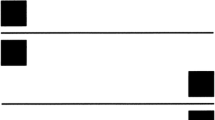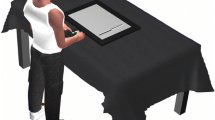Abstract
Previous studies have shown that flanking distractors influence line bisection. In the present study, we examined if reaching the flanker after bisecting the line resulted in a variation of flanker interference on line bisection. Right- and left-handed participants were asked to bisect a horizontal line flanked by a dot (bisection task, B-task) or to bisect the line and then to reach the dot (bisection plus reaching task, BR-task). The dot was placed laterally to, and above or below, the line edge. The results showed that in both tasks the subjective midpoint was shifted away from the position of the dot. However, this effect was greater in the BR-task than in the B-task. We suggest that the requirement to perform an action to the flanker in the BR-task induced participants to pay more attention to the dot, enhancing its salience and distorting effects on line bisection.


Similar content being viewed by others
References
Anderson B (1996) A mathematical model of line bisection behaviour in neglect. Brain 119:841–850
Baldauf D, Deubel H (2009) Attentional selection of multiple goal positions before rapid hand movement sequences: an event-related potential study. J Cogn Neurosci 21:18–29
Baldauf D, Wolf M, Deubel H (2006) Deployment of visual attention before sequences of goal-directed hand movements. Vision Res 46:4355–4374
Bartolomeo P (2007) Visual neglect. Curr Opin Neurol 20:381–386
Benwell CS, Harvey M, Gardner S, Thut G (2013a) Stimulus- and state-dependence of systematic bias in spatial attention: additive effects of stimulus-size and time-on-task. Cortex 49:827–836
Benwell CS, Thut G, Learmonth G, Harvey M (2013b) Spatial attention: differential shifts in pseudoneglect direction with time-on-task and initial bias support the idea of observer subtypes. Neuropsychologia 51:2747–2756
Bisiach E, Vallar G (1988) Hemineglect in humans. In: Boller F, Grafman J (eds) Handbook of neuropsychology, vol 1. Elsevier, Amsterdam, pp 195–222
Bowers D, Heilman KM (1980) Pseudoneglect: effects of hemispace on a tactile line bisection task. Neuropsychologia 18:491–498
Bradshaw JL, Nathan G, Nettleton NC, Wilson L, Pierson J (1987) Why is there a left side underestimation in rod bisection? Neuropsychologia 25:735–738
Chao LL, Knight RT (1995) Human prefrontal lesions increase distractibility to irrelevant sensory inputs. NeuroReport 6:1605–1610
Charles J, Sahraie A, McGeorge P (2007) Hemispatial asymmetries in judgment of stimulus size. Percept Psychophys 69:687–698
Chieffi S (1996) Effects of stimulus asymmetry on line bisection. Neurology 47:1004–1008
Chieffi S (1999) Influence of perceptual factors on line bisection. Cortex 35:523–536
Chieffi S, Ricci M (2002) Influence of contextual stimuli on line bisection. Percept Mot Skills 95:868–874
Chieffi S, Gentilucci M, Allport A, Sasso E, Rizzolatti G (1993) Study of selective reaching and grasping in a patient with unilateral parietal lesion. Dissociated effects of residual spatial neglect. Brain 116:1119–1137
Chieffi S, Ricci M, Carlomagno S (2001) Influence of visual distractors on movement trajectory. Cortex 37:389–405
Chieffi S, Iavarone A, Carlomagno S (2008) Effects of spatiotopic factors on bisection of radial lines. Exp Brain Res 189:129–132
Chieffi S, Iavarone A, Viggiano A, Monda M, Carlomagno S (2012) Effect of a visual distractor on line bisection. Exp Brain Res 219:489–498
Chokron S, Brickman AM, Wei T, Buchsbaum MS (2000) Hemispheric asymmetry for selective attention. Brain Res Cogn Brain Res 9:85–90
Desimone R, Duncan J (1995) Neural mechanisms of selective visual attention. Annu Rev Neurosci 18:193–222
Deubel H, Schneider WX (2004) Attentional selection in sequential manual movements, movements around an obstacle, and in grasping. In: Humphreys GW, Riddoch MJ (eds) Attention in action. Psychology Press, Hove, pp 69–91
Dufour A, Touzalin P, Candas V (2007) Time-on-task effect in pseudoneglect. Exp Brain Res 176:532–537
Fink GR, Marshall JC, Halligan PW, Dolan RJ (1999) Hemispheric asymmetries in global/local processing are modulated by perceptual salience. Neuropsychologia 37:31–40
Fischer MH (1994) Less attention and more perception in cued line bisection. Brain Cogn 25:24–33
Friedman-Hill SR, Robertson LC, Desimone R, Ungerleider LG (2003) Posterior parietal cortex and the filtering of distractors. Proc Natl Acad Sci USA 100:4263–4268
Halligan PW, Marshall JC (1989) Line bisection in visuo-spatial neglect: disproof of a conjecture. Cortex 25:517–521
Halligan PW, Manning L, Marshall JC (1990) Individual variation in line bisection: a study of four patients with right hemisphere damage and normal controls. Neuropsychologia 28:1043–1051
Halligan PW, Manning L, Marshall JC (1991) Hemispheric activation vs spatio-motor cueing in visual neglect: a case study. Neuropsychologia 29:1065–1076
Harvey M, Milner AD, Roberts RC (1995) An investigation of hemispatial neglect using the landmark task. Brain Cogn 27:59–78
Heilman KM, Watson RW, Valenstein E (2003) Neglect and related disorders. In: Heilman KM, Valenstein E (eds) Clinical neuropsychology, 4th edn. Oxford University Press, New York, pp 296–346
Howard LA, Tipper SP (1997) Hand deviations away from visual cues: indirect evidence for inhibition. Exp Brain Res 113:144–152
Keulen RF, Adam JJ, Fischer MH, Kuipers H, Jolles J (2007) Distractor interference in selective reaching: effects of hemispace, movement direction, and type of movement. Cortex 43:531–541
LaBerge D (1995) Computational and anatomical models of selective attention in object identification. In: Gazzaniga MS (ed) The cognitive neurosciences. MIT Press, Cambridge, pp 649–663
LaBerge D, Buchsbaum MS (1990) Positron emission tomographic measurements of pulvinar activity during an attention task. J Neurosci 10:613–619
Manly T, Dobler VB, Dodds CM, George MA (2005) Rightward shift in spatial awareness with declining alertness. Neuropsychologia 43:1721–1728
Mattingley JB, Pierson JM, Bradshaw JL, Phillips JG, Bradshaw JA (1993) To see or not to see: the effects of visible and invisible cues on line bisection judgements in unilateral neglect. Neuropsychologia 31:1201–1215
Mattingley JB, Bradshaw JL, Bradshaw JA (1995) The effects of unilateral visuospatial neglect on perception of Müller-Lyer illusory figures. Perception 24:415–433
McCourt ME, Jewell G (1999) Visuospatial attention in line bisection: stimulus modulation of pseudoneglect. Neuropsychologia 37:843–855
McCourt ME, Garlinghouse M, Reuter-Lorenz PA (2005) Unilateral visual cueing and asymmetric line geometry share a common attentional origin in the modulation of pseudoneglect. Cortex 41:499–511
McNab F, Klingberg T (2008) Prefrontal cortex and basal ganglia control access to working memory. Nat Neurosci 11:103–107
Milner AD, Brechmann M, Pagliarini L (1992) To halve and to halve not: an analysis of line bisection judgements in normal subjects. Neuropsychologia 30:515–526
Neggers SFW, Schölvinck ML, van der Lubbe RHJ, Postma A (2005) Quantifying the interactions between allocentric and egocentric representations of space. Acta Psychol 118:25–45
Neggers SFW, van der Lubbe RHJ, Ramsey NF, Postma A (2006) Interactions between ego- and allocentric neuronal representations of space. Neuroimage 31:320–331
Nichelli P, Rinaldi M, Cubelli R (1989) Selective spatial attention and length representation in normal subjects and in patients with unilateral spatial neglect. Brain Cogn 9:57–70
Oldfield RC (1971) The assessment and analysis of handedness: the Edinburgh inventory. Neuropsychologia 9:97–113
Post RB, O’Malley MD, Yeh TL, Bethel J (2006) On the origin of vertical line bisection errors. Spat Vis 19:505–527
Rizzolatti G, Berti A (1990) Neglect as a neural representation deficit. Rev Neurol 146:626–634
Rueckert L, Deravanesian A, Baboorian D, Lacalamita A, Repplinger M (2002) Pseudoneglect and the cross-over effect. Neuropsychologia 40:162–173
Ruotolo F, Iachini T, Postma A, van der Ham IJ (2011a) Frames of reference and categorical and coordinate spatial relations: a hierarchical organisation. Exp Brain Res 214:587–595
Ruotolo F, van der Ham IJ, Iachini T, Postma A (2011b) The relationship between allocentric and egocentric frames of reference and categorical and coordinate spatial information processing. Q J Exp Psychol 64:1138–1156
Scarisbrick DJ, Tweedy JR, Kuslansky G (1987) Hand preference and performance effects on line bisection. Neuropsychologia 25:695–699
Shelton PA, Bowers D, Heilman KM (1990) Peripersonal and vertical neglect. Brain 113:191–205
Shiffrin RM (1988) Attention. In: Atkinson RC, Herrnstein RJ, Lindzey G, Luce RD (eds) Stevens’ handbook of experimental psychology, vol 2. Wiley, New York, pp 739–811
Sosa Y, Teder-Sälejärvi WA, McCourt ME (2010) Biases of spatial attention in vision and audition. Brain Cogn 73:229–235
Suzuki S, Cavanagh P (1997) Focused attention distorts visual space: an attentional repulsion effect. J Exp Psychol Hum Percept Perform 23:443–463
Thiebaut de Schotten M, Dell’Acqua F, Forkel SJ, Simmons A, Vergani F, Murphy DG, Catani M (2011) A lateralized brain network for visuospatial attention. Nat Neurosci 14:1245–1246
Tipper SP, Lortie C, Baylis GC (1992) Selective reaching: evidence for action-centered attention. J Exp Psychol Hum Percept Perform 18:891–905
Toba MN, Cavanagh P, Bartolomeo P (2011) Attention biases the perceived midpoint of horizontal lines. Neuropsychologia 49:238–246
Umiltà C (1988) Orienting of attention. In: Boller F, Grafman J (eds) Handbook of neuropsychology, vol I. Elsevier, Amsterdam, pp 175–193
Vallar G, Daini R, Antonucci G (2000) Processing of illusion of length in spatial hemineglect: a study of line bisection. Neuropsychologia 38:1087–1097
Viggiano A, Chieffi S, Tafuri D, Messina G, Monda M, De Luca B (2013) Laterality of a second player position affects lateral deviation of basketball shooting. J Sports Sci. doi:10.1080/02640414.2013.805236
Yovel G, Yovel I, Levy J (2001) Hemispheric asymmetries for global and local visual perception: effects of stimulus and task factors. J Exp Psychol Hum Percept Perform 27:1369–1385
Author information
Authors and Affiliations
Corresponding author
Rights and permissions
About this article
Cite this article
Chieffi, S., Iachini, T., Iavarone, A. et al. Flanker interference effects in a line bisection task. Exp Brain Res 232, 1327–1334 (2014). https://doi.org/10.1007/s00221-014-3851-y
Received:
Accepted:
Published:
Issue Date:
DOI: https://doi.org/10.1007/s00221-014-3851-y




